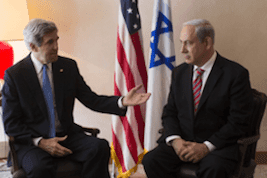When A Mediator Wants an Agreement More Than the Parties
By Chuck Doran and Katie Hyten, MWI Mediators
 After trying to broker a ceasefire between Israel and Hamas, Kerry has been somewhat unceremoniously extricated from the conflict resolution processes. And as Israel pulled back from US mediation efforts in favor of an Egypt-brokered process, Kerry saw his efforts to mediate a settlement fall apart for the second time in as many years. Egyptian-brokered ceasefires have remained largely intact, while Kerry’s involvement has been universally berated.
After trying to broker a ceasefire between Israel and Hamas, Kerry has been somewhat unceremoniously extricated from the conflict resolution processes. And as Israel pulled back from US mediation efforts in favor of an Egypt-brokered process, Kerry saw his efforts to mediate a settlement fall apart for the second time in as many years. Egyptian-brokered ceasefires have remained largely intact, while Kerry’s involvement has been universally berated.
Barak Ravid at Haaretz declared: “If Kerry did anything on Friday it was to thwart the possibility of reaching a cease-fire in Gaza. Instead of promoting a cease-fire, Kerry pushed it away.” Avi Issacharoff at The Times of Israelnoted: “Israel, the Palestinian Authority, Egypt, Saudi Arabia and Jordan were all in agreement that Kerry’s efforts were undermining the attempt to bring about a ceasefire between Israel and Hamas as quickly as possible. Moreover, Kerry’s framework and the ideas he presented led to an extraordinary phone call taking place between a senior Palestinian Authority official and an Israeli counterpart, during which the two mocked the senior diplomat’s naiveté and his failure to understand the regional reality.”
It is astonishing that both Israelis and Palestinians now believe that the U.S. peace process actively worked against their interests, and that both parties agreed to turn to the new Egyptian government to serve as the facilitator of the peace process. And yet, John Kerry still seeks to further his involvement in the process. In July, Kerry declared at the Center for American Progress: “Make no mistake, when the people of Israel are rushing to bomb shelters, when innocent Israeli and Palestinian teenagers are abducted and murdered, when hundreds of innocent civilians have lost their lives, I will and we will make no apologies for our engagement.” In August, State Department spokesperson Jen Psaki said the US would likely participate in the Cairo talks. Despite efforts by Israelis and Palestinians to shun American involvement in the talks, Kerry remains involved.
What this Means for the Mediation Process
The ramifications of Kerry’s insisted involvement has reverberated beyond his role simply as a mediator. In highlighting these unintended consequences, we recognize lessons applicable to the broader field of mediation.
First, the insistence on U.S. involvement in this peace process has hindered relations between the U.S. and Israel. The former American Ambassador to Israel Daniel Kurtzer declared: “This is the most sustained period of antagonism in the relationship… I don’t know how the relationship recovers as long as you have this president and this prime minister.” When mediating parties work to force their involvement in a settlement, they threaten the fundamental relationship they have with each party.
Second, the neutrality of Secretary Kerry as a mediator has been compromised, as both main parties to the conflict now see the American government as actively working against their interests. This risks the legitimacy of the U.S. as a broker of peace alongside risking the relationship between the U.S. and both Israel and Palestine.
Finally, and most importantly, this raises a question: If an agreement or mediator is forced upon both parties, what effect does that have on the success of the agreement? To answer this question, we can look to two historical examples. In Bosnia, Richard Holbrooke pushed his way into the peace process in the midst of a horrifying civil conflict, structuring every aspect of the final Dayton Accords. Although this peace agreement lead to a cessation of violence, it did not end the hatred among religious communities. To this day, Bosnia-Herzegovina remains separated into distinct religious communities with separate governing bodies and state institutions, rendering the national government largely inept and dysfunctional. Protests have erupted requesting change, and nothing has been done to promote reconciliation or trust among religious groups. In his account of the peace process, Holbrooke admitted outright: “The Western mistake over the previous four years had been to treat the Serbs as rational people with whom one could argue, negotiate, compromise and agree. In fact, they respected only force or an unambiguous and credible threat to use it.”
And in the Compromise of 1850, two figureheads in American politics, Henry Clay and John C. Calhoun, debated Clay’s contentious proposal for how to manage the division of slavery in territory gained in the Mexican-American war. In the raucous debate that followed (at one point Henry Foote of Mississippi drew a pistol on Senator Benton), Stephen Douglas crafted a compromise largely based on Henry Clay’s work, splitting the original proposal into five separate bills so that each senator could abstain or vote no on the component which with he disagreed. Each of the bills passed, delaying a serious discussion on the future of slavery in the United States. Most controversially, the packaged Compromise included a “fugitive slave law” requiring northerners to return runaway slaves to their owners. Historians have since argued that this Compromise preempted the outbreak of the Civil War, and acted as one of the last straws in the breakdown of peaceful efforts to address the issue.
Lessons Learned for Mediation
The cases of John Kerry in Israel-Palestine, Richard Holbrooke in Bosnia-Herzegovina, and Henry Clay in the U.S. Senate of 1850 each showcase a simple lesson: mediators should focus their energies on managing the process and engaging the parties so as to avoid pushing an outcome of the mediator’s choosing. These case studies also give insight into that process.
First, no group of people should be bound by an agreement to which they did not agree. If the parties do not choose the mediator or agree to the process, but are forced to make a decision anyway, this removes the informed consent necessary to a successful agreement and runs the risk that the agreement will not satisfy their interests. In 1850, this strategy forced both Clay and Calhoun to live with portions of the Compromise they disagreed with at a fundamental level. Furthermore, the compromise addressed the fates of an entire group of people not represented in the process.
Second, forced agreements by a mediator (an involuntary process) leaves both parties ultimately unsatisfied and ends with a greater possibility for future resurgence of conflict. In Bosnia, Bosnian Muslims and Christians were often forced by Holbrooke to agree to terms to which they would not have otherwise approved. As such, Bosnian communities have not reconciled, built trust, or learned to cooperate in the country’s government.
Successful mediations occur when both parties request the mediator, when all relevant parties have a seat at the table, and the process remains voluntary for all involved. For an agreement to be successful, the parties must build an agreement based on their interests, informed consent, and voluntary participation. As mediators, it is our job to build a process that guarantees these components without investing in the outcome of the process. The parties, and only the parties, are responsible for a settlement.
Free webinar on how to become a mediator – click here to register






